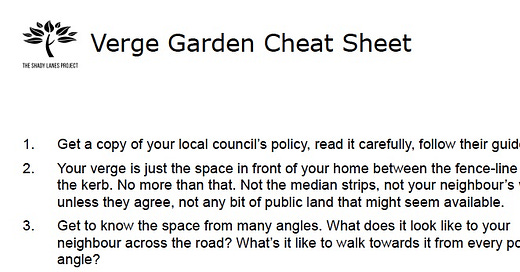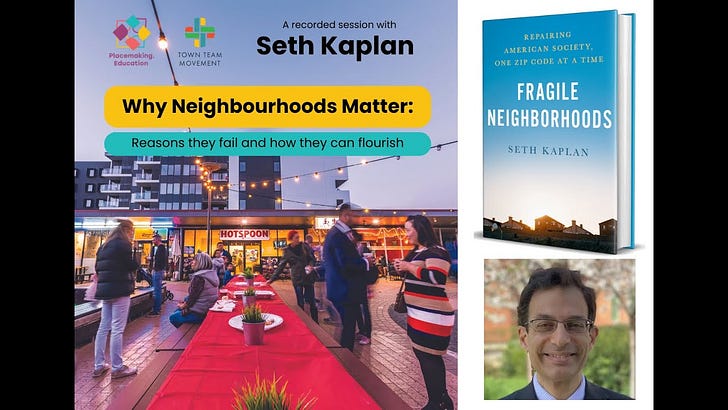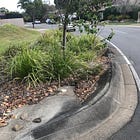Verge Garden Cheat Sheet
Verge gardening is complex. Here are TL;DR (too long; didn't read) guidelines for verge gardening that will keep you and your group projects on track.
Almost everyone underestimates the complexity of verge gardening when they start. I know I did. That means underestimating the opportunities as well.
I started my verge garden because I didn’t want to mow the grass. No mowing is a good enough reason in itself. It was only when I started planting that I discovered it was a special place for conversations with neighbours, and conversations with strangers. It is our hyperlocal commons.
This was the inspiration for The Shady Lanes Project and an ongoing journey of discovery about how our humble verges create opportunities to nurture the diverse networks and collaborations needed to tackle climate change and biodiversity loss.
But who wants to read all that? I’ve done these cheat sheets up for group projects, working bees, and displays on stalls (print A3 and laminate).
There is a PDF version that you can download for printing at the end.
12 points to keep you out of trouble
Get a copy of your local council’s policy, read it carefully, follow their guidelines.
Your verge is just the space in front of your home between the fence-line and the kerb. No more than that. Not the median strips, not your neighbour’s verge unless they agree, not any bit of public land that might seem available.
Get to know the space from many angles. What does it look like to your neighbour across the road? What’s it like to walk towards it from every possible angle?
Where do you need to leave clear space for pedestrians? Remember all ages and abilities. This isn’t stepping stones through your lovely garden, it is part of their route from A to B.
Where do you have to leave clear space for people getting out of cars? You could have mulch or a flat green strip (grass or groundcovers). You might have to lower the ground close to the kerb to ensure mulch is not washed into drains.
Where do you have to leave clear space for the postie and meter readers?
If you have a street tree, take care not to disturb the roots or smother with soil or thick mulch (tree roots need to breathe). If you don’t have a tree, contact your council and ask for one.
What is the easiest and least contentious space? This is probably against the fenceline or around a tree. If you have a hostile neighbour, do it as far away from them as possible. Do this spot first and it will allow for time and conversations to reassure people that you’re not going to wreck their neighbourhood.
Choose your plants – think about their eventual size and growth habits. You don’t want plants attacking the legs of pedestrians or getting in the spokes of wheels.
Plant local native plants from community nurseries. These plants are suited to your climate and soil. Do your research – what grows well in other gardens nearby. Think about the sun/shade at different times of day. Native plants don’t need rich soil and often don’t like thick mulch. At most, add a little compost (and a lot of water) in the bottom of the hole you put them in and mulch lightly.
Consider flowers that delight people, rounded balls of westringia facing hedge-loving neighbours, plants at different levels to add interest.
Do it bit by bit. Stand back and watch how it changes the space. Watch how people react. Reflect on how you react. If you take out a bit of grass and put in a plant, you can nurture them as you move on and do the next bits until all the grass is gone.
For more, see the free Verge Garden Basics - Understanding the Space course.
Understanding the Space
The second page (or reverse side if you print double-sided) shows the articles in the free Verge Garden Basics - Understanding the Space. Each item can be used as a discussion starter with your group.
Download
The PDF file is A4 sheet is suitable for handouts or on displays.






